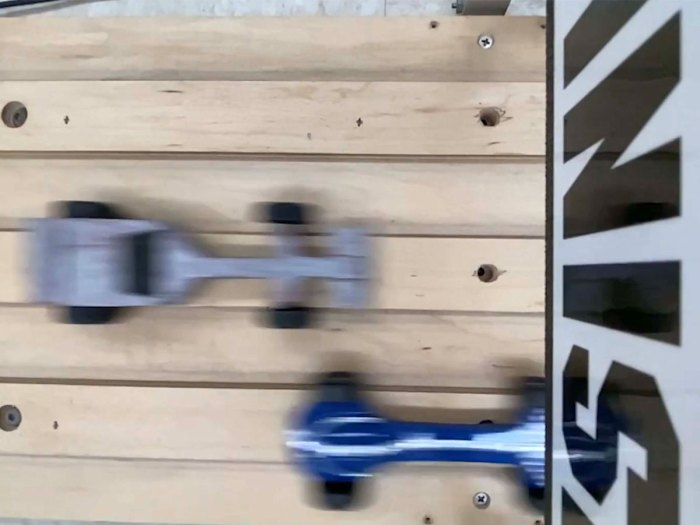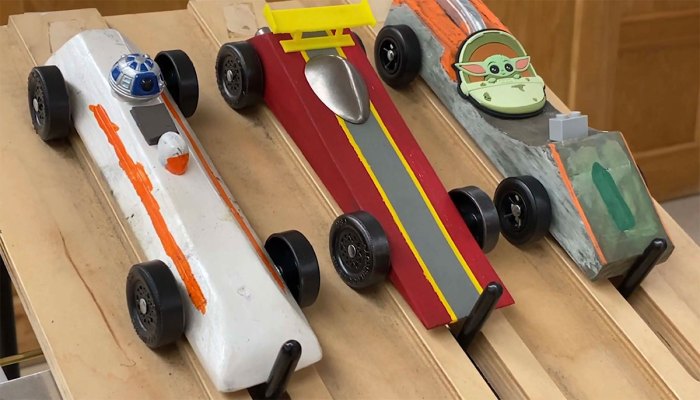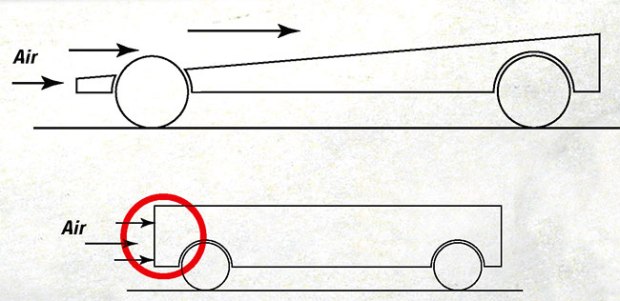How to Make a Fast Pinewood Derby Car

Packs nationwide are gearing up for their annual Pinewood Derby race, and the one thing everyone wants to know: How do I make a fast Pinewood Derby car?
There are a variety of ways to make your Pinewood Derby car go faster. Explore the following tips to optimize your car’s performance and gain a competitive edge in an upcoming race.
BASIC BUILDING GUIDELINES TO GET YOU STARTED
The possibilities are endless when it comes to creating a fast Pinewood Derby car. Before you begin, consider the following general guidelines:
Avoid Pointed Noses: A pointed nose will make it difficult for your car to rest on the pin at the starting gate. It may also cause your Pinewood Derby car to get bumped around when the pin drops, and it can create problems for electronic timing systems at the finish line.
Weight Distribution: Leave ample wood in the rear of the Pinewood Derby car so you can place additional weight there. Concentrate the majority of the weight in the rear for optimal performance.
Maximum Weight: Aim for the maximum allowable weight allowed by your pack’s rules, typically limited to 5 ounces in most races. If your car falls short of this weight, strategically add coins or other weights to meet the requirement.
Clarity in Orientation: Clearly distinguish the front and back of your Pinewood Derby car. In many races, the race officials — not you — will actually place each car on the track. Sometimes the officials put cars on the track backward because they can’t tell which end is which.
Aerodynamic Design: Select a design that facilitates smooth airflow over and around the car body. Pinewood Derby cars with aerodynamic profiles go faster.
Need design ideas? See photo galleries of hundreds of Pinewood Derby cars.

10 STEPS FOR DESIGNING AND BUILDING A FAST PINEWOOD DERBY CAR
You don’t have to strive for the fastest Pinewood Derby car to have fun competing in your Pinewood Derby. But if you and a helpful adult are willing to put in the extra time and effort, these speed tips are for you.
1. Bake the Block: Start your Pinewood Derby car project by baking the wood block at 250 degrees for two hours. This removes moisture and lightens the block, allowing you to place more weight at the rear of the car where you actually want it.

2. Crafting the Design: Outline your Pinewood Derby car on paper, cut it out, and affix it to the wood block.
Remember, a rectangular car is not an aerodynamic design. The most basic aerodynamic design is a simple wedge. If you don’t have time to design a complex car, a wedge will work just fine.
Download a Pinewood Derby car template PDF to help you create your design.
3. Rough Cut the Design: Use a coping saw or enlist the help of a responsible adult with a power tool to cut out the rough shape of your Pinewood Derby car.
4. Shape Your Car: Smooth edges and shape your car using sandpaper. An adult can assist with a rotary tool or other shaping tools.
5. Sand and Paint Creatively: Reduce friction by smoothing the car’s surface and paint an awesome design to make it look great.
How to paint your Pinewood Derby car to give it a shiny finish.
6. Axles and Wheels Alignment: Make sure they are aligned perfectly straight. You can test the alignment of your axles by pushing your car across a smooth floor or table. It should roll smoothly in a straight line.
- Consider a Three-Wheeler: Raise one wheel about 1/16 inch higher so it never actually touches the track. Less friction = more speed. Rules vary from pack to pack, so make sure to check your pack’s Pinewood Derby rules to make sure three wheelers are allowed in your race.
- Extend the Wheelbase: Maximize the distance between front and rear wheels. Again, make sure this is allowed in your race.
Inspect axles closely to make sure they are smooth without ridges or burrs. You can use sandpaper to remove any imperfections.
Learn about polishing Pinewood Derby axles and wheels to reduce friction.
7. Secure Axles with Glue: Glue the axles firmly in their holes to ensure that they stay perfectly placed, but make sure you don’t get glue on your wheels.
8. Strategic Weight Addition: Remember to make your Pinewood Derby car as heavy as the rules allow. In general, it’s best to place weight to the rear of your car because a heavier rear increases speed.
Learn scientific Pinewood Derby speed tips from a former NASA engineer.
9. Use Graphite: Add graphite or another dry lubricant to reduce friction. The less friction between the body and wheel, the better.
10. Have fun! And finally, remember the most important rule of a Pinewood Derby is that it’s supposed to be fun. While you should always strive to do your best, don’t get caught up in winning or having the fastest car. Just enjoy the ride.
Adapted from the book “Pinewood Derby Speed Secrets,” DK Publishing, $12.95 softcover.
What are the dimensions?
Does spoiler help?
awesome
this year was my sons first race. He designed the car. I don’t have a saw at home so I took it to work and cut it out. My son did everything else but paint. He wanted it to be chameleon green to gold, he put on the primer and base coat. I painted the green with a airbrush. I would say that he did 90% of the work which was my goal. It is his event after all. I will work on getting a band saw and drill press so he can do all the work himself next year.
I helped (And I mean HELPED) my grandson build his first pine box derby car. Much to my disappointment, the “contest” was which adult could build the best car.
We bought the wedge at the scout shop, drilled the 3 holes on the side for weight, the kids did the sanding. We did nothing to the axles or wheels, did not use graphite, and still had the fastest and third fastest cars in the meet – with about 64 cars competing, including adults. My Webelo has already started planning for next year, shopping for axles, etc. My Tiger (who took second overall) intends to build a fire truck next year.
Is it against the rules to cover your axles so they don’t show
he didn’t cover them. He just carved around them.
These look helpful.
First rule should be: Your child physically makes at least 95-100% of the car. These tips (such as weight in the back and such) serve to help junior finish the race in a respectable time. And winning is also great, but if junior watched while ‘Dad’ smoothed the axles, graphited the wheels, chose the aerodynamic design, etc., then the point of this event is lost! It is why I love the rain gutter regatta, the boys win based on their performance. Keep the boys as the focus, not your own pride. And use these tips to help guide a winning experience.
I agree, the boy should do the majority of the work. One year our pack had a derby clinic and the boys and their parents built their cars together. It was great fun but it would be difficult to do if the pack had a lot of kids and there was not a meeting place with the right tools. Some people are also secretive which is okay if everything is kept legal. The raingutter regatta is fun and so is the space derby. Great comments on your part keep it up. Derby Goof.
i’ve gotten 8th on my first try and 1st on my second try
1st! that is awesome!
is it better to put the weights in the back of the car or underneath this is our first time making the car and trying to figure this out. and how are the weight held in??
Thanks
Ifound that putting your weights on top in the rear of the car.We run a flat car put our weights in the rear put some putty on and then we sand the car the way we want it to look. The hard part is making sure when its sanded that when you add the tires,axles and paint the car that its not over 5 oz.
yes.